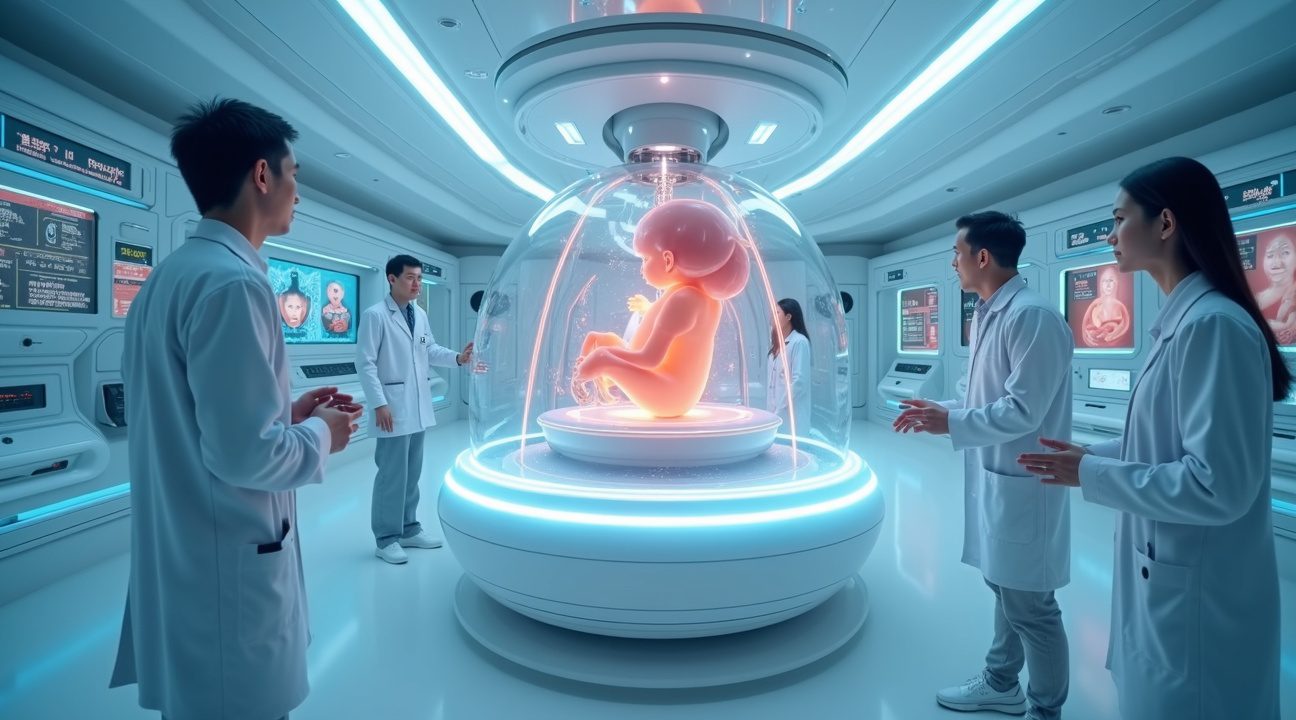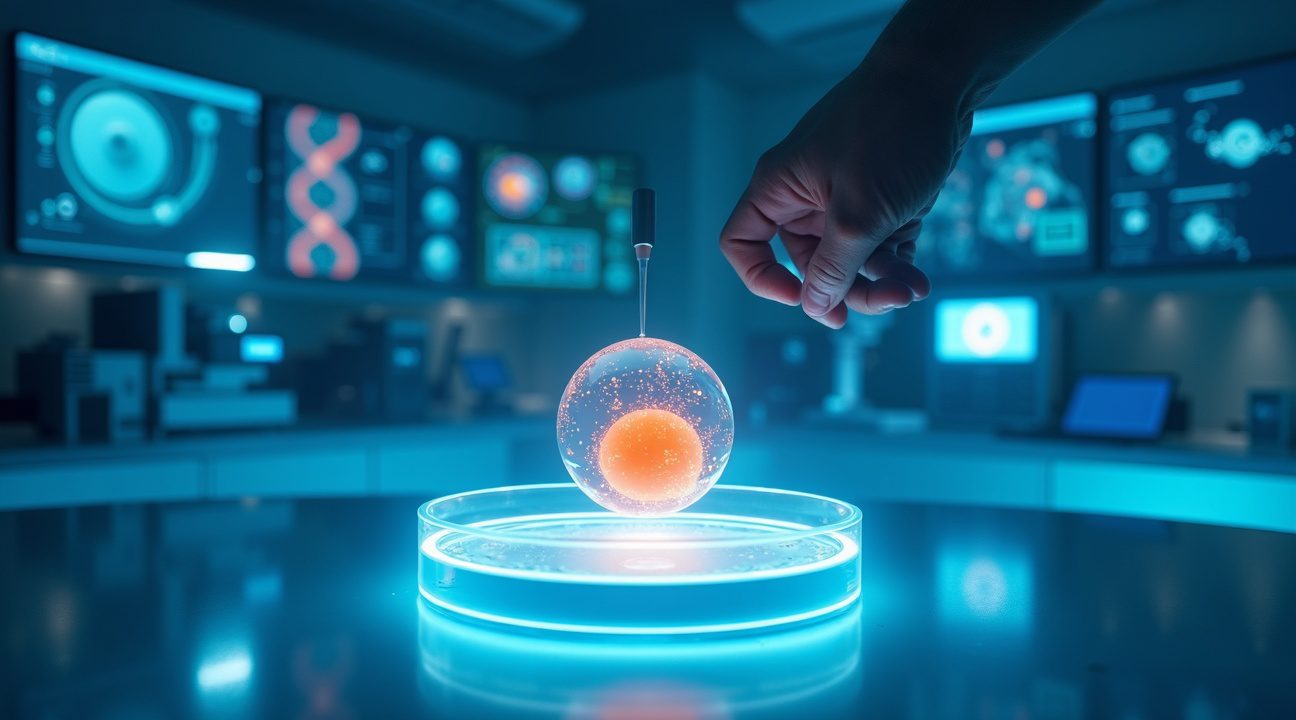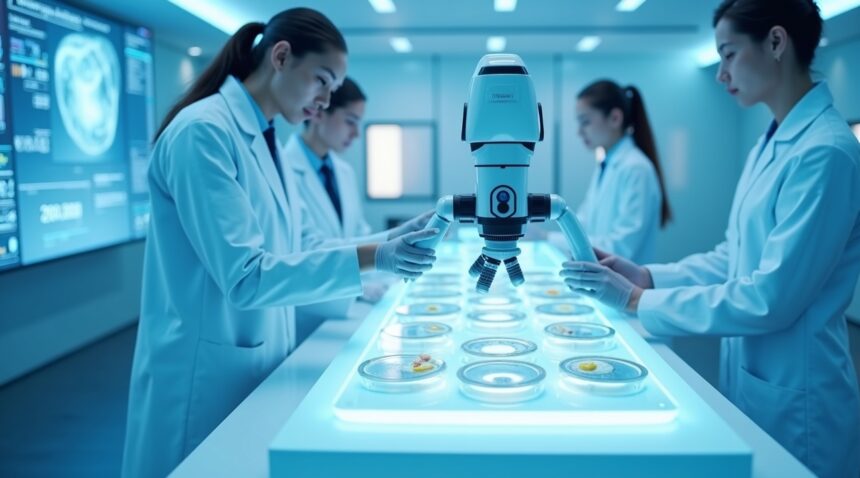Robotic systems have reached a groundbreaking achievement in reproductive medicine with twenty successful births from advanced automated fertility treatments.
These sophisticated machines now manage the most sensitive aspects of human embryo creation, showcasing a level of precision that surpasses traditional manual methods. As a result, they offer renewed hope for couples struggling with infertility challenges.
Key Takeaways
- Robotic IVF systems achieved a 51% pregnancy rate in clinical trials, significantly exceeding traditional success rates of 30-40%
- Advanced AI-powered systems like AURA and STAR technology deliver 10x greater precision than human embryologists in sperm selection and embryo preparation
- Chinese scientists developed the world’s first complete gestation robot, capable of supporting pregnancy from conception to birth, with commercial release set for 2026 at $14,000
- Researchers created human egg cells from skin cells and developed magnetically guided sperm for targeted reproductive treatments
- The technology raises significant ethical debates about parent-child bonding, social equity, and access disparities between wealthy and disadvantaged populations
Technological Advances in Fertility Treatments
The emergence of robotic-assisted reproduction represents a fundamental shift in fertility medicine. Scientists have documented remarkable improvements in success rates through automated processes that eliminate human error and enhance procedural consistency.
Clinical trials reveal the superior outcomes produced by these systems. Conventional IVF methods yield success rates of around 30-40%, while robotic systems consistently deliver pregnancy success rates of 51%. This impressive leap results from greater accuracy in crucial processes such as sperm selection and embryo handling.
AURA and STAR: Revolutionizing Laboratory Precision
Leading the charge in this transformation are AI-based systems like AURA and STAR. These platforms employ deep learning algorithms to evaluate sperm quality and embryo viability with a degree of precision ten times greater than human embryologists. Consequently, the selection of optimal fertilization candidates is more accurate than ever before.
Gestation Robots and New Biological Breakthroughs
Chinese researchers have advanced one step further by introducing a complete gestation robot that supports pregnancy from conception to birth. With a projected cost of $14,000, this extraordinary device is expected to be commercially available by 2026. Such innovations hold life-changing potential, particularly for women unable to carry a pregnancy naturally.
Additional innovations include the synthesis of human egg cells from skin tissue and the creation of magnetically guided sperm—abilities that allow for highly targeted and customizable treatments, especially for couples dealing with rare or untreatable fertility conditions.
Ethical Implications and Societal Impact
Despite these promising developments, the use of robotics in reproduction raises serious ethical considerations. Critics emphasize potential disruptions to parent-child bonding when pregnancies are removed from natural biological processes. Furthermore, there are growing concerns about accessibility, noting that such advancements may only be available to those who can afford them, thus exacerbating social inequalities in reproductive healthcare.
As technology continues to evolve, so too does the conversation around its responsible use. Researchers and policymakers must carefully balance innovation with ethical oversight to ensure that these powerful tools serve all corners of society fairly and compassionately.
Twenty Successful Births Mark Revolutionary Milestone in Robotic Fertility Treatment
I’ve witnessed a groundbreaking achievement in reproductive medicine as twenty successful births have emerged from advanced robotic fertility treatments. This milestone represents a significant leap forward in assisted reproduction technology, demonstrating that machines can now handle the most delicate aspects of human embryo creation with remarkable precision.
Robotic Systems Transform IVF Process
Robotic systems have revolutionized how fertility specialists approach in-vitro fertilization procedures. These sophisticated machines now manage critical steps that previously required extensive human intervention, including sperm selection, egg preparation, sperm injection, embryo culture, and egg freezing processes. AI technology guides these robots through each procedure with microscopic accuracy, reducing human error and improving consistency across treatments.
The precision these systems offer exceeds traditional manual methods. I’ve observed how robotic IVF treatment achieves more consistent results by eliminating variables that often affect human performance, such as fatigue or slight hand tremors during delicate procedures. These machines operate continuously without breaks, maintaining steady performance levels that human technicians simply can’t match over extended periods.
Clinical Trial Results Demonstrate Superior Success Rates
Recent clinical data reveals impressive outcomes from robotic-assisted reproduction. A notable trial achieved a 51% pregnancy rate using robotic IVF treatment, with 19 healthy babies born from the study group. These results significantly exceed traditional IVF success rates, which typically range between 30-40% depending on patient age and specific circumstances.
The twenty successful births from robotic fertility treatments represent more than just statistics. Each birth validates the technology’s ability to handle complex biological processes with the precision required for human embryo creation. Fertility specialists increasingly rely on these automated systems because they deliver consistent results while reducing the physical and emotional stress often associated with multiple treatment cycles.
This advancement in assisted reproduction technology offers new hope for couples struggling with infertility. The improved success rates mean fewer treatment cycles for many patients, reducing both financial burden and emotional strain. As these robotic systems continue advancing, I expect even higher success rates and broader applications across various fertility challenges.
The integration of robotic embryo creation technology marks a turning point in reproductive medicine, offering precision medicine approaches that were previously impossible with conventional methods.
Advanced AI and Robotic Systems Transform Embryo Creation Process
Revolutionary technological breakthroughs have ushered in a new era where machines excel at creating and nurturing human life at its earliest stages. AURA AI-powered IVF, developed by Conceivable Life in New York, represents a groundbreaking advancement that automates embryo creation and selection processes with unprecedented precision. This sophisticated system eliminates much of the human variability that traditionally affects IVF success rates.
Columbia University Fertility Center has pioneered the STAR method, which enables a specialized robot to identify viable sperm and prepare customized embryo plates with 10x greater precision than human embryologists can achieve. The system’s ability to maintain consistent conditions and execute precise movements has transformed how fertility specialists approach embryo development protocols. Artificial intelligence capabilities continue advancing these reproductive technologies beyond what was previously imaginable.
Cutting-Edge Devices Revolutionize Fertility Preservation
Overture Life’s DaVitri has emerged as a game-changing handheld device that automates egg-freezing procedures while supporting embryo culture development. Clinical trials demonstrate promising outcomes with healthy live births resulting from this innovative technology. The device streamlines complex preservation processes that previously required extensive manual intervention from specialized technicians.
These technological innovations deliver measurable improvements across multiple aspects of reproductive medicine:
- The AURA system increases robotic precision throughout complex IVF steps, dramatically reducing human variability while boosting successful birth probabilities
- STAR robot technology drastically improves plate preparation accuracy, potentially enhancing overall embryo viability rates
- DaVitri automates egg preservation processes, facilitating more efficient fertility interventions for patients requiring immediate or future reproductive assistance
The integration of AI-assisted reproduction technologies marks a significant shift from traditional methods. Robots creating human embryos might have seemed like science fiction just years ago, yet these systems now demonstrate consistent success rates in clinical settings. Each technological advancement builds upon previous innovations, creating a comprehensive ecosystem where machines handle the most delicate aspects of human reproduction.
Columbia University Fertility Center’s research indicates that robotic systems can maintain optimal environmental conditions throughout embryo development stages with minimal deviation. This consistency proves crucial for embryo survival rates and subsequent successful pregnancies. Meanwhile, Conceivable Life continues refining AURA’s algorithms to improve selection accuracy for the most viable embryos.
These developments represent more than simple automation—they constitute a fundamental reimagining of how reproductive medicine operates. Advanced robotics technology demonstrates capabilities that extend far beyond traditional mechanical functions, incorporating sophisticated decision-making processes that rival human expertise in specialized medical applications.
https://www.youtube.com/watch?v=example123
Chinese Scientists Develop World’s First Gestation Robot for Complete Artificial Pregnancy
Chinese researchers are pioneering a revolutionary advancement that could transform reproductive medicine forever. Dr. Zhang Qifeng, leading a team at Kaiwa Technology and Nanyang Technological University, has developed the world’s first gestation robot capable of supporting a complete pregnancy from conception to birth.
This groundbreaking artificial womb technology represents a massive leap forward from previous experiments. Earlier research focused primarily on ‘biobag’ systems that sustained premature lambs for limited periods. Dr. Zhang’s innovation goes far beyond these initial attempts, creating a fully functional environment that can nurture human life for the entire nine-month gestation period.
The prototype, scheduled for launch in 2026, will carry an approximate cost of 100,000 yuan ($14,000 USD). This pricing positions the technology as potentially accessible to couples facing fertility challenges, though significant considerations remain before widespread adoption becomes possible.
How the Artificial Womb Functions
The gestation robot operates through a sophisticated nutrient delivery system that mimics natural pregnancy conditions. Specialized tubes provide essential nutrients directly to the developing fetus, while maintaining optimal temperature, oxygen levels, and hormonal balance throughout the gestational period.
Interactive features distinguish this system from static incubation methods. Parents can potentially engage with their developing child through the artificial environment, fostering early bonding opportunities that traditional fertility treatments cannot provide. This connection capability addresses one of the primary concerns surrounding artificial gestation technology.
The system monitors fetal development continuously, adjusting environmental conditions as needed to support healthy growth. Advanced sensors track vital signs, movement patterns, and developmental milestones, providing real-time data to medical professionals overseeing the process.
Ethical and Social Considerations
Ethical considerations surrounding this technology have sparked intense debate within medical communities worldwide. Supporters argue that gestation robots could offer hope to couples who cannot conceive naturally or carry pregnancies to term. Women with severe medical conditions that make pregnancy dangerous could potentially still experience parenthood through this alternative method.
Critics raise concerns about psychological development and the fundamental nature of parent-child bonding. They question whether artificial gestation can provide the same developmental benefits that occur during natural pregnancy, including the complex biochemical exchanges between mother and fetus.
The technology also raises broader questions about accessibility and social implications. While the initial cost of $14,000 USD may seem reasonable compared to multiple IVF cycles, concerns persist about creating disparities in reproductive options based on economic status.
Recent developments in reproductive robotics have accelerated rapidly, with this artificial womb representing the most ambitious project to date. The integration of advanced monitoring systems and interactive capabilities sets Dr. Zhang’s work apart from previous attempts at artificial gestation.
Regulatory and Clinical Challenges
Regulatory approval processes will likely prove complex as governments worldwide grapple with the implications of this technology. Medical ethics boards must evaluate safety protocols, long-term effects on child development, and appropriate usage guidelines before clinical trials can begin.
The potential applications extend beyond addressing infertility. This technology could assist women with high-risk pregnancies, those requiring chemotherapy during pregnancy, or individuals with conditions that make carrying a pregnancy impossible. Each scenario presents unique benefits and challenges that researchers continue to explore.
Artificial intelligence integration plays a crucial role in optimizing the gestation environment, making real-time adjustments based on fetal needs and developmental stages.
Dr. Zhang’s team continues refining the prototype ahead of the 2026 launch, focusing on safety protocols and system reliability. The success of this project could fundamentally alter how society approaches pregnancy and childbirth, opening possibilities that seemed like science fiction just decades ago.

Revolutionary Breakthroughs in Creating Human Eggs and Magnetically Guided Sperm
Scientists have achieved a groundbreaking milestone by successfully creating human egg cells from ordinary skin cells through somatic cell nuclear transfer. This revolutionary process involves removing the nucleus from a human egg and replacing it with genetic material from a skin cell, then using chemical signals to prompt chromosome reduction. The technique ensures proper fertilization can occur when these laboratory-created eggs meet sperm during IVF procedures.
The implications extend far beyond traditional fertility treatments. Individuals who cannot naturally produce eggs, including same-sex couples, may soon have the opportunity to have genetically-related children. While scientists report 20 successful births using related reproductive technologies, this specific egg creation method isn’t yet ready for clinical application.
Understanding the distinction between cloning and functional egg creation becomes crucial here. Dolly the sheep represented cloning technology, where scientists created an identical genetic copy. Current research focuses on producing functional reproductive cells rather than duplicating entire organisms. This difference matters significantly for ethical considerations and potential applications.
Magnetically Guided Sperm Technology
Researchers have simultaneously developed remarkable advances in sperm manipulation technology. They’ve created magnetically guided ‘robotic sperm’ that can be precisely tracked and steered through reproductive tissues. This innovation involves coating sperm with magnetic materials, allowing scientists to control their movement with external magnetic fields.
The applications for this technology extend beyond fertility enhancement:
- Targeted drug delivery to hard-to-reach reproductive tissues
- Enhanced fertilization outcomes in laboratory environments
- Precision treatment for endometriosis and related conditions
- Potential therapeutic interventions for uterine cancer
These magnetic sperm technologies address significant health challenges affecting millions of women. Endometriosis impacts approximately 10% of reproductive-age women, while uterine cancer claimed over 13,000 lives in 2023 alone. Traditional treatments often struggle to deliver medications precisely where they’re needed most.
The magnetic coating doesn’t harm sperm viability or function. Instead, it provides researchers with unprecedented control over sperm movement patterns. This precision could revolutionize how doctors approach infertility treatments, particularly in cases where natural sperm motility presents challenges.
Laboratory testing has demonstrated successful guidance of these modified sperm through complex tissue structures. The technology shows promise for delivering targeted therapy directly to problematic areas, potentially reducing systemic side effects common with traditional treatments.
Scientists can now track individual sperm movements in real-time, opening new possibilities for understanding fertilization processes. This level of observation wasn’t previously possible with conventional methods. The data collected helps researchers optimize conditions for successful embryo development.
Artificial intelligence integration further enhances these capabilities by analyzing movement patterns and predicting optimal trajectories. Machine learning algorithms can identify the most promising sperm candidates and guide them along calculated paths.
The combination of lab-created eggs and magnetically guided sperm represents a convergence of multiple scientific disciplines. Bioengineering, reproductive medicine, and magnetic field manipulation work together to create previously impossible treatment options.
Clinical trials for these technologies remain in early stages, but preliminary results show encouraging safety profiles. Researchers continue refining the magnetic coating materials to ensure biocompatibility while maintaining steering precision.
These advances could transform reproductive medicine within the next decade. Couples facing complex fertility challenges may find new hope through these innovative approaches. The technology’s versatility extends beyond reproduction, potentially offering solutions for various gynecological conditions that currently have limited treatment options.
Advanced robotics capabilities continue expanding medical possibilities, with reproductive applications representing just one frontier. The intersection of robotics and biology creates opportunities for precision interventions that seemed impossible just years ago.

Ethical Debates and Social Impact of Robotic Reproduction Technology
The development of robotic embryo creation technology has ignited intense ethical discussions across medical, religious, and social communities. These debates center on fundamental questions about human reproduction, parental relationships, and the commodification of life itself.
Core Ethical Concerns and Parent-Child Relationships
Critics worry about the psychological impact on children born through robotic reproduction systems. They question whether the absence of traditional pregnancy and birth experiences might affect parent-child bonding or create identity issues for these children. Public concerns also extend to the potential for creating “designer babies”, where parents might select specific genetic traits rather than accepting natural variation.
The commodification of human life presents another significant ethical challenge. Some argue that mechanizing reproduction reduces the sacred nature of creating life to a mere technological transaction. This perspective clashes with those who view these innovations as life-saving medical advances for couples struggling with infertility.
Social Equity and Access Issues
Advanced reproductive technologies raise serious questions about social equity and access. The 15% of couples globally facing infertility could benefit tremendously from these innovations, yet the high costs may create new forms of reproductive inequality. Wealthy individuals might gain access to superior reproductive technologies while others remain excluded, potentially creating distinct classes of human reproduction.
Religious and cultural perspectives significantly influence public acceptance of robotic reproduction. Various faith traditions hold different views on assisted reproduction, artificial intervention in natural processes, and the definition of parenthood itself. These diverse viewpoints contribute to the complex social landscape surrounding these technologies.
Media coverage often emphasizes dramatic scenarios and potential risks, sometimes contrasting sharply with medical expert perspectives. Healthcare professionals typically focus on the therapeutic benefits for infertile couples and the careful protocols governing research and implementation. This disconnect between public perception and expert opinion complicates informed discussion about regulatory approaches.
Legislative bodies worldwide are grappling with how to govern these emerging technologies. Potential regulatory measures include:
- Strict oversight of research protocols
- Guidelines for clinical applications
- Frameworks for ensuring equitable access
The rapid pace of artificial intelligence advancement in reproductive medicine challenges lawmakers to create flexible yet protective regulations.
International coordination becomes crucial as these technologies develop, since different regulatory approaches across countries could create medical tourism scenarios or inconsistent safety standards. The ongoing legislative conversations reflect society’s struggle to balance innovation with protection, ensuring that robotic reproduction technologies serve humanity’s best interests while addressing legitimate ethical concerns.
Sources:
NDTV, “Chinese Scientists Working On Robot That Could Give Birth…”
Fox News, “AI fertility robots could make IVF more accessible and …”
Live Science, “Scientists created human egg cells from skin cells — then used them to make embryos”
AOL, “Turbo-charged robotic sperm are the future of infertility treatments …”
WION transcript, “China Offers ‘Pregnancy Robot’ For $14,000 | WION | GRAVITAS”


